Innovation—the creation of new ideas, products, and services—has become increasingly important as a source of energy and funding in the social sector. Traditional nonprofit business models are being questioned, the rate of global change seems faster than organizations’ ability to keep pace, and there is a growing sense that the old ways of solving problems no longer work. Funders and grantees alike are incorporating innovation into their work—as we see in the rise of social innovation departments in major global NGOs and United Nations agencies like UNICEF—and they are building the capacity of their teams to get better at innovating.
But when it comes to established sectors like health, education, or business incubation, how might anyone provide something truly new? Can you set out to change the way a sector works?
There are, of course, multiple examples of this in the private sector—think of how Cirque du Soleil disrupted the circus industry or Yellow Tail tapped into a new customer base for wine. But there are fewer cases in the social sector, where we don’t know if social innovators, funders, and business plan competitions think systematically about how/whether their innovation is actually new (do we really need another fuel-efficient cookstove or mobile app for farmers?). How can we do better?
An Approach for Evaluating Innovation
“Value innovation” is a strategic approach that can help organizations create and deliver unique, differentiated value rather than engage in direct head-to-head competition. Based on the work of W. Chan Kim and Renée Mauborgne of Blue Ocean Strategy—a term that refers to accessing new or untapped markets ripe for your product or service—this approach aims to help innovators achieve two things:
- Create a leap in value for consumers (or beneficiaries) by eliminating compromises that the sector forces beneficiaries to make and by introducing new elements that entice non-beneficiaries to begin consuming an organization’s offering. By increasing the artistic nature of its show, for example, Cirque du Soleil was able to attract a new adult audience—people less interested in traditional, child-oriented circuses and prepared to pay higher prices.
- Reduce organizational costs associated with delivering greater value by eliminating factors the sector takes for granted but that no longer have value, and by optimizing the offering to avoid over-serving beneficiaries for no gain. Yellow Tail, for example, began offering a narrower range of wines and ignored things like vineyard prestige in favor of creating a fun brand that was easy to consume.
Are you enjoying this article? Read more like this, plus SSIR's full archive of content, when you subscribe.
To learn how social sector organizations might benefit from thinking systematically about value innovation, we recently created a workshop for fellows of our intensive social innovation program at Amani Institute. To make the approach as experiential and easy to grasp as possible, we applied it to business incubators, co-working spaces, and accelerators in Nairobi.
We chose these innovation-oriented communities, or “hubs,” for the following reasons:
- Given widespread youth unemployment in the country, there is much attention on how entrepreneurship could spur employment and economic growth in Kenya.
- Hubs have proliferated globally in recent times, and nowhere more so than Nairobi.
- There is a great diversity of hubs in Nairobi: business hubs, tech hubs, maker spaces, social impact hubs, university hubs, and arts hubs.
- Despite global investment in hubs, it’s still unclear how well the concept works, both in terms of sustainability and impact.
Five hubs signed up for the project. Here, we share our findings in the aggregate, as they are relevant not just to hubs, but also other organizations interested in social innovation or enterprise design.
Value Innovation in Practice
We started by asking each organization: What do you really do? What stood out right away was that nearly everyone answered in terms of services (what they provide), not value (what customers want). But being more disciplined about understanding value can improve your ability to innovate. New possibilities begin to open up when hubs offer connectivity, not just wi-fi, or when they offer skills to build a business, not just training.
The next step was to put these offerings in context, comparing them to other products and services in the field. A useful way to do this is by drawing an industry’s value curve—creating a graphical description of the factors organizations compete on and the level of investment they make in those factors. In value curves, the horizontal axis depicts the sector’s competitive factors while the vertical axis depicts the level of investment in each competitive factor.
Hubs, for example, compete on factors such as connectivity, skill-building, and access to experts. The horizontal axis of the value curve therefore would comprise factors such as the ability to glean ideas from others in a co-working space, while the vertical axis would depict the amount the hub invests in running that co-working space and hence the degree to which their users benefit.
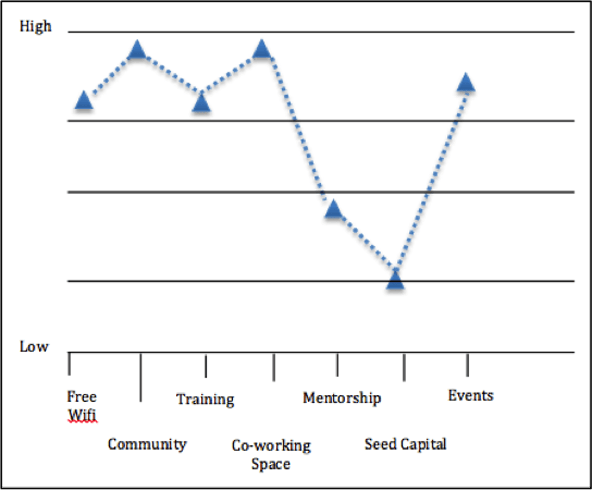 A generic value curve for the hub industry could look something like this.
A generic value curve for the hub industry could look something like this.
We use these value curves to identify which investments provide greater value to customers and which differentiate the organization from its competitors. From there, a simple matrix called the Four Actions Framework allows us to look at value curves and determine what to eliminate, what to reduce, what to raise, and what to create to provide more value relative to others in your industry.
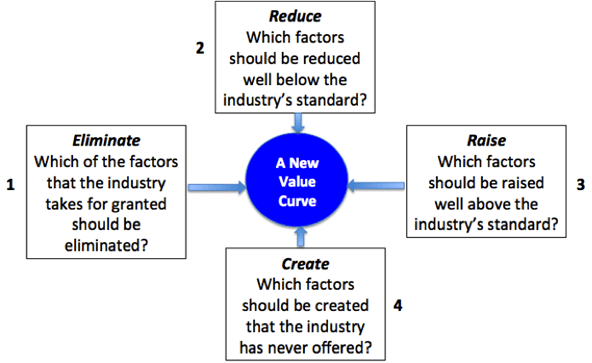 The Four Actions Framework.
The Four Actions Framework.
To illustrate the framework, before coming back to our hubs, let’s use an example from another field: higher education.
Over the last decade, frustrated by the failings of universities to adequately prepare changemakers for their careers, a number of “alternative” higher education institutions—such as TechChange, THNK, Watson University, and Amani Institute—have launched around the world. Each has its own unique approach and target audience, but generally speaking, they have done the following in comparison to traditional master’s degrees:
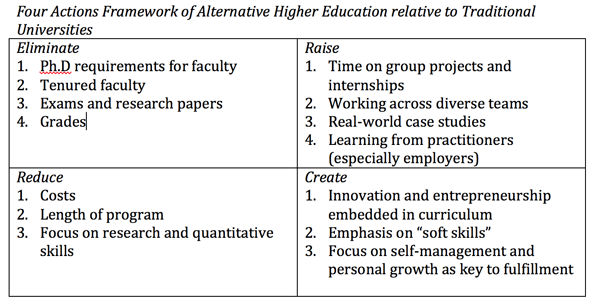 An analysis of alternative higher education institutions relative to traditional universities using the Four Actions Framework.
An analysis of alternative higher education institutions relative to traditional universities using the Four Actions Framework.
The Four Actions Framework can help you see how your industry compares to possible substitutes for what you offer, but it can be even more useful to help create an offering that is divergent from that of your competitors. Going back to our case study, one of our hubs might have had the following findings from their value curve:
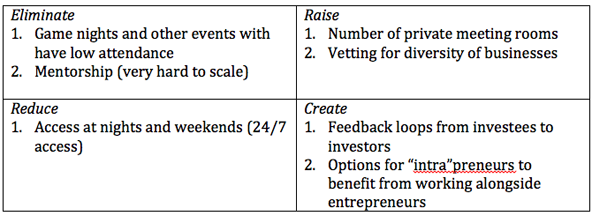 How a single hub can seek to innovate its service offerings relative to its competitors.
How a single hub can seek to innovate its service offerings relative to its competitors.
And therefore, a new value curve for a hub seeking to differentiate itself might look like this.
Lessons for Organizations Everywhere
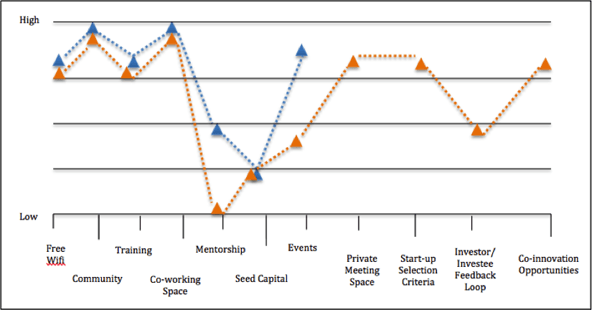 A potential value curve for the hub industry.
A potential value curve for the hub industry.
We believe organizations across a range of different sectors—not just hubs—can benefit from this analysis.
- Focus on value, not services. Most organizations are internally driven, focusing on the services they provide rather than on the needs of their beneficiaries. With regard to hubs, this may be a reason why few successful businesses have spun out of them. In addition, this internal focus results in cost structures that are not optimized and investments that result in little value for the hubs’ beneficiaries.
- Navigate a fragmented industry. In most sectors, there is a lack of coordination and collaboration between players. Hubs are no exception, and improving this could result in a systematic progression from market research and ideation, to product design and testing, to seed capital, to scaling up.
- Strategic partnerships around a mutual target audience. Many organizations have access to audiences that a larger stakeholder would also benefit from. For instance, university-based hubs have access to an important market segment: youth. These hubs could benefit from business agreements with companies whose products target youth.
- Add value to intrapreneurs. The “intrapreneurship” movement—where people drive change from within a large organization—is actively looking for ways to learn from entrepreneurs. Hubs could create greater value by extending their services to “intrapreneurs” who seek access to new ideas, markets, and networks. This is already happening in many countries, though not to our knowledge yet in Kenya.
Ultimately, if we’re serious about innovation for social good, we need to systematically apply tools that help generate new ideas and scale our work. Imagine a progressive organization (say, a life-skills education nonprofit) eyeing the divide in America today between liberals and conservatives. If such an organization could figure out how to get voters from the other party to use their programs, they could access a vast new market (or “blue ocean”) for their services and thus have a much bigger impact than their competitors. This is the type of fresh thinking we believe the value innovation approach has the potential to unleash.
Support SSIR’s coverage of cross-sector solutions to global challenges.
Help us further the reach of innovative ideas. Donate today.
Read more stories by Nasreen Dhanji & Roshan Paul.

